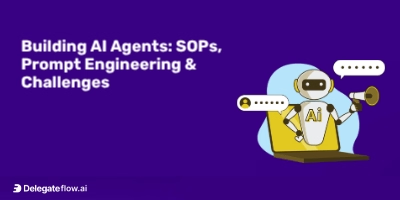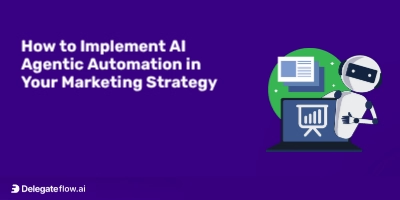How to Build a No-Code AI Workflow with DelegateFlow: A Step-by-Step Guide
In the ever-evolving business landscape, automating operations has become a vital component for success. No-code AI workflows provide organizations with the ability to optimize processes and focus on innovation without the need for extensive coding expertise. By simplifying tedious tasks and enhancing overall productivity, businesses can redirect their resources towards strategic initiatives.
This guide will walk you through the essential steps to create effective no-code AI workflows with DelegateFlow, a platform designed for ease of use and functionality. Discover the immense potential of automating your operations and how it can benefit your team and organization.
Table of Contents
- Introduction
- Why Choose No-Code AI Workflows?
- Getting Started with DelegateFlow
- Building Your No-Code AI Workflow
- Testing and Improving Your Workflow
- Conclusion
- Frequently Asked Questions
- Common Mistakes to Avoid

DelegateFlow stands out as a powerful platform dedicated to helping businesses create AI-driven workflows without needing any coding expertise. Built with user-friendliness in mind, DelegateFlow enables users to construct workflows using a straightforward approach, aligning perfectly with the demand for optimization in marketing, sales, and creative processes. This not only publicizes their professional image but allows for rapid scaling of operations with ease.
Here are a few reasons why no-code AI workflows and DelegateFlow are essential for modern businesses:
- Time-Saving: Automate tedious tasks and reclaim hours in your week. DelegateFlow's AI agents take care of repetitive processes, allowing you to concentrate on strategic initiatives.
- Accessibility: By eliminating the need for coding knowledge, DelegateFlow makes powerful automation accessible to all team members, fostering creativity and collaboration.
- Dynamic Adaptation: The ability to quickly adapt workflows in response to changing market demands means that your business remains competitive and relevant.
- Integration: DelegateFlow's seamless integration with existing tools such as WordPress and Shopify makes it an indispensable addition to your operational toolkit.
Discover how DelegateFlow can help reshape your business operations by exploring our platform, and take your first steps into no-code automation today.

For further insights and a deep dive into how DelegateFlow can empower your business processes, visit our use cases page.
Discover the Power of AI in Your Workflow
Embracing Artificial Intelligence (AI) stands to benefit marketing professionals and business leaders alike. From automating repetitive tasks to boosting productivity, AI-driven processes are reshaping workflows across various domains. Let’s explore how AI can empower your marketing strategy and growth trajectory.
Understanding AI-driven processes is crucial. By implementing AI in your operations, you can:
- Optimize Time Management: AI can handle tedious tasks, enabling you to focus on strategic initiatives and creative thinking.
- Improve Decision-Making: AI tools can analyze large data sets quickly, providing insights that help in making informed marketing decisions.
- Enhance Targeting: AI allows for more precise audience segmentation and personalization, leading to improved engagement and conversion rates.
One standout tool that facilitates this automation is DelegateFlow. This no-code AI-powered workflow platform allows marketers to automate complex tasks with ease. Key functions include:
- Task Automation: Streamline operations such as content scheduling, keyword research, and reporting, replacing manual processes with intelligent agents.
- Customization: Tailor workflows to suit your specific needs, allowing flexibility in how you approach your marketing tasks.
- Performance Tracking: Get real-time analytics on your automated tasks, ensuring you're always informed and adapting strategies effectively.
Another vital aspect of DelegateFlow is its dedication to empowering users at all skill levels. With no-code solutions, even those without technical expertise can easily set up and manage workflows. This democratization of technology is particularly beneficial in:
- Enhancing Collaboration: Teams can work together more efficiently, with everyone being able to contribute to workflow creation.
- Reducing Dependency: Eliminate the need for specialized knowledge to implement advanced automation techniques.
- Adapting Quickly: As business needs change, users can swiftly modify their workflows without needing to consult with developers.
In summary, integrating AI into your workflow presents substantial benefits in terms of time savings, strategic insight, and operational agility. Embrace the opportunity to implement these innovative solutions, and watch your marketing efforts improve. Ready to join a new era of productivity? Start exploring DelegateFlow today.

Step-by-Step Guide: Generate Your Brand Book
Creating a brand book is crucial for establishing a solid foundation for your marketing efforts. It serves as a reference point for your brand's identity, values, and voice, ensuring consistency across all marketing channels. Here’s why having a brand book matters:
- Consistency: A brand book helps maintain uniformity in messaging and visual aesthetics. This is essential for building trust with your audience.
- Clarity: It provides a clear picture of your brand’s mission and vision, guiding your marketing strategy and campaigns.
- Alignment: With a defined brand book, your team can align their efforts and understand how to communicate your brand effectively.
Now, let's walk through creating a brand book using DelegateFlow's features:
- Identify Your Brand Essentials: Start by outlining your brand's values, mission, and vision. This will form the heart of your brand book.
- Gather Visual Assets: Compile logos, color palettes, typography, and imagery that represent your brand. DelegateFlow allows you to store and manage these assets efficiently.
- Articulate Your Brand Voice: Define the tone and language that reflect your brand's personality. This section will guide your content creation and communications.
- Create Guidelines: Develop specific guidelines on how to use your visual and written elements across different platforms. This ensures your brand remains cohesive in various contexts.
- Leverage DelegateFlow's AI Features: Use DelegateFlow's AI capabilities to analyze your branding materials, suggesting modifications to enhance consistency and relevance.
Using AI for your brand book has distinct advantages:
- Consistency: AI helps ensure that each piece of content adheres to your brand guidelines, creating a unified brand voice.
- Efficiency: Automating the branding process saves time and resources, letting you focus on strategy and creative tasks.
- Scalability: As your business grows, AI can adapt your brand book guidelines to meet evolving market demands and consumer expectations.
With DelegateFlow, you can create a targeted, adaptable brand book that strengthens your marketing and aligns your entire team under a shared vision. After establishing your brand book, clone this AI Blog Generator workflow to get started on creating content that resonates with your audience. This makes it easy to launch consistent blog posts ready for integration into platforms like Webflow, WordPress, or Shopify.

By utilizing DelegateFlow's features, you're not just setting up a brand book; you're laying down the groundwork for a powerful marketing strategy that will resonate with your audience and establish your brand as a vital player in your industry.
Cloning the AI Blog Generator Workflow
In today's fast-paced digital landscape, having an effective workflow can make all the difference in your content creation process. With DelegateFlow, you can clone successful workflows—an empowering feature that allows you to replicate what works best for your marketing strategy. Here’s how to do just that!
Understanding the Cloning Process in DelegateFlow
The cloning process of the AI blog generator workflow in DelegateFlow is simple, intuitive, and saves you precious time. You begin by selecting a workflow that you have already set up or one that stands out as successful in the platform's gallery. With just a few clicks, you can create an identical copy that includes every action and trigger from the original workflow. This becomes your foundation for further enhancements or adaptations tailored to your business's unique needs.
Adapting Workflows to Suit Your Business Needs
Once you've cloned a workflow, the next step is customization. Here’s how you can adapt the cloned AI blog generator workflow:
- Identify Specific Goals: Understand the priorities of your brand. Are you optimizing for SEO, driving user engagement, or enhancing visibility? Tailor your workflow actions accordingly.
- Modify Actions: Add, remove, or modify the actions in your workflow to ensure they align with your current project objectives. For instance, if your focus is SEO-driven blogs, adjust the keyword research and content clustering actions to target relevant search phrases.
- Test & Refine: After adjusting the workflows, it’s essential to test the process. Use your inputs to evaluate the output and refine further to optimize results.
The Benefits of Cloning Workflows
Utilizing cloned workflows is not just a time-saver; it can revolutionize the way you manage your content creation tasks. Here are key benefits:
- Time-Saving: By starting with a proven framework, you minimize the time spent on designing workflows from scratch, allowing you to focus on content quality.
- Resource Efficiency: Streamlined processes mean fewer resources are wasted on trial and error. Your team can efficiently produce quality content without getting stuck in redundant tasks.
- Consistent Quality: Cloning successful workflows helps maintain a standard in content quality and performance, making it easier to scale your marketing efforts.
In conclusion, cloning workflows within DelegateFlow empowers you to optimize your content strategy. With simple adaptations, you can ensure that your blog generation process is easier and aligned with your strategic business goals.

Testing with Your Inputs
Before diving into full implementation of your AI-generated blog workflow, it's crucial to first test your setup. This phase is not just an extra step; it's a valuable opportunity to ensure your entire process functions as intended, with the right inputs leading to desirable outputs. Testing allows you to identify potential glitches, misunderstandings, or areas for improvement, ultimately setting the stage for a more productive deployment.
To effectively test your workflow in DelegateFlow, consider the following approaches:
- Importance of Testing Your Workflow: Testing your workflow before full implementation is essential. It helps in refining your process and guarantees everything runs smoothly when you go live. By catching issues early, you reduce the risk of costly errors down the line.
- Inputting Real Data for Effective Testing: In DelegateFlow, using real data for testing dramatically increases the accuracy of your results. Input data that mirrors what you expect in normal operations. This could include blog topics, images, keywords, and any other parameters pertinent to your content generation example. Testing with realistic scenarios provides insights into how your workflow will behave in actual conditions, helping you address any shortcomings proactively.
- Analyzing Results and Adjusting Workflows: After testing your inputs, gather and analyze the results. Look for trends or common themes in the data. If certain inputs produce underwhelming outputs, adjust those workflows accordingly. Fine-tuning is part of the process, ensuring that each element of your workflow works optimally before it is fully launched.
Remember, testing is not just a step; it's a foundation for a robust workflow. Taking the time to thoroughly test with your inputs will make all the difference in achieving successful and sustained performance in your AI blog generation and beyond.

Finetuning for Optimal Results
Finetuning your AI workflow can lead to better results and improved performance. Below we will explore optional steps that improve workflow outcomes, effective techniques for adjusting AI agents, and how finetuning impacts overall campaign success.
Overview of Optional Steps for Enhancing Workflow Performance: There are various strategies that can be employed to fine-tune your AI-driven processes:
- Regularly Review Outputs: Analyze the results generated by your AI tools. Are they meeting your expectations in terms of quality and relevance?
- Implement User Feedback: Gather insights from users interacting with the AI outputs. This can inform necessary adjustments.
- Conduct A/B Testing: Experiment with different parameters or variations of your AI workflow to identify which configurations yield the best results.
- Integrate Continuous Learning: Ensure that your AI models are updated with new data and algorithms, allowing them to learn and improve.
Techniques for Adjusting AI Agents: To get the most out of your AI agents, specific adjustments may be necessary. Here are some techniques:
- Tuning Hyperparameters: Fine-tune settings like learning rates and batch sizes to refine how your AI learns.
- Curation of Training Data: Select high-quality, relevant training data that aligns closely with your goals, helping your AI to produce more targeted outputs.
- Adjusting AI Models: Depending on your needs, switch to more suitable models or layers that enhance performance for specific tasks.
- Utilizing Feedback Loops: Establish mechanisms that allow your AI to learn from previous performance feedback, making ongoing improvements a natural part of the workflow.
Impact of Fine-Tuning on Overall Efficiency and Campaign Success: Fine-tuning has a profound effect on both your processes and the success of your campaigns:
- Increased Productivity: A well-tuned AI can handle tasks quickly and with higher accuracy, freeing up time for more strategic actions.
- Improved Quality of Output: Fine-tuning enhances the relevance and effectiveness of content, which can lead to better engagement and conversion rates.
- Data-Driven Decisions: The adjustments you make will ground your strategy in solid data analytics, allowing you to pivot when needed.
- Long-Term Success: The focus on consistent improvement and adjustments leads to sustainable campaign success, positioning you ahead of your competition.
In conclusion, fine-tuning is a critical component of maximizing your AI workflow's performance and effectiveness. With deliberate adjustments and a focus on continuous improvement, your campaigns can achieve significant levels of success.

Integrate with Your CMS for Publishing
Integrating DelegateFlow with your Content Management System (CMS) opens up a realm of possibilities, bringing your marketing content strategy to life with just a few clicks. Whether you run a blog on Webflow, WordPress, or Shopify, our platform maximizes your content efforts without the need for coding expertise.
Integration Options Available with DelegateFlow
- Webflow: Enjoy easy publishing with the ability to automate and schedule your content. DelegateFlow allows you to create optimized blog posts that can be published directly on your Webflow site, combining workflow efficiency with responsive design.
- WordPress: As one of the leading blogging platforms, WordPress integration saves time and energy. Automatically publish your content or save as drafts for further collaboration and review before going live.
- Shopify: Ideal for online stores, our integration with Shopify allows you to create content that promotes your products, improving SEO and driving traffic directly to your ecommerce pages.
Steps for Setting Up and Leveraging Integrations Effectively
- Connect Your Account: Use your DelegateFlow credentials to connect with your chosen CMS (Webflow, WordPress, or Shopify). Each integration comes with simple instructions to ensure you’re set up quickly.
- Create Your Content: Use DelegateFlow to generate SEO-optimized blog posts that resonate with your target audience.
- Select Your Publishing Option: Choose either to publish directly or save your work as a draft. If your team collaborates on content, drafts allow for reviews and input from multiple perspectives.
- Review and Publish: If you opted for a draft, review your work through your CMS, make any necessary adjustments, and publish when ready.
Benefits of Direct Publishing vs. Saving as Draft for Collaborative Efforts
- Direct Publishing: This method is perfect for time-sensitive content. When you’re ready to go live, one click is all it takes, ensuring your audience receives updates.
- Saving as Draft: If your strategy revolves around collaborative efforts, this option allows for multiple editors to review and tweak content before it reaches your audience, ensuring high-quality output.
Integrating with your CMS not only simplifies the publishing process but also improves your overall workflow. As you align your marketing efforts with powerful AI technologies, DelegateFlow empowers you to improve quality and consistency across your brand’s voice. For more insights, check out our Knowledge Base.

Conclusion: Your Next Steps with DelegateFlow
As you embark on your journey to optimize AI workflows with DelegateFlow, it's essential to recap the pivotal steps that can set you on the path to success. By utilizing this no-code platform, you can not only automate processes but also boost your marketing capabilities with ease.
Here’s a recap of the key steps to help you get started with DelegateFlow for AI workflows:
- Generate Your Brand Book: Craft a foundational document that encapsulates your brand’s identity, mission, and vision. This crucial first step will guide your content strategy.
- Clone the AI Blog Generator Workflow: Access our ready-made templates and clone them for use. This feature eliminates the need for complex setup, allowing you to hit the ground running.
- Test With Your Inputs: Input your specific data into the cloned workflow to see how it fits your needs. This hands-on approach ensures that you understand each component perfectly.
- Fine-tune Actions or Agents: Optionally, you can optimize the actions or agents within the workflow for tailored outputs or enhanced performance.
- Integrate with Your CMS: For those interested in expanding capabilities, integrate with platforms like Webflow, WordPress, or Shopify to publish blogs directly or save them as drafts.
As simple as these steps may seem, the impact they can have on your marketing strategy is profound. Now is the perfect time to explore DelegateFlow and begin crafting your own AI-driven workflows. With the aim of automating tedious tasks, you will be empowered to focus on what truly matters: unleashing your creativity and making data-backed decisions.
If you're looking to take the next step in your journey with AI, remember to delve into the Knowledge Base for further insights. Engaging with our resources will deepen your understanding and enable you to utilize the full potential of DelegateFlow.
Your new no-code workflow awaits, so let’s get started!

Frequently Asked Questions
DelegateFlow brings unparalleled benefits across various industries, enabling them to optimize operations and amplify productivity. Here’s a closer look at who can take advantage of DelegateFlow, its accessibility to beginners, and support resources for tackling challenges.
- What types of businesses can benefit from using DelegateFlow?
DelegateFlow is designed for a wide variety of sectors, including:
- Marketing Agencies: Improve campaign execution and tracking.
- E-commerce Businesses: Automate product listings and content generation.
- Content Creators: Simplify the content creation process, managing multiple projects with ease.
- Tech Startups: Scale workflows without the need for extensive coding resources.
- Consulting Firms: Manage client projects with more streamlined processes.
- How easy is it to learn to use DelegateFlow for a beginner?
DelegateFlow is intuitively built to facilitate a quick learning curve, even for those without technical backgrounds. Key features include:
- No-Code Interface: Users can create workflows without any programming knowledge.
- Step-by-Step Guides: Comprehensive tutorials and documentation are available, guiding newcomers through initial setup and usage.
- Templates: Pre-built workflows enable quick launches and experimentation.
- What support resources are available if I encounter challenges?
DelegateFlow provides an array of support resources to ensure users have assistance when needed:
- Knowledge Base: A well-maintained Knowledge Base with articles covering common questions and advanced topics.
- Community Forum: Engage with other users and experts for shared insights and solutions.
- Live Chat Support: Real-time assistance is available, allowing direct communication with the support team.
With these resources, businesses can confidently implement DelegateFlow into their workflows and unlock numerous productivity benefits.

Common Mistakes to Avoid When Building Workflows
Creating efficient workflows is crucial for fully utilizing automation tools like DelegateFlow. However, many individuals and teams encounter pitfalls that can hinder their success. Here are some common mistakes to avoid that can streamline your workflow-building process:
- Skipping the testing phase: One of the most significant errors teams make is bypassing the testing phase. Testing ensures that all elements of your workflow function as expected. Without it, you risk implementing workflows that might break or produce unintended outputs, leading to wasted time and resources. Take the time to run tests and revise any aspects that don’t perform as needed.
- Overcomplicating workflows: While it’s tempting to create complex workflows that cover every scenario, simplicity often trumps complexity. Keeping workflows straightforward leads to better comprehension and easier troubleshooting. Instead of trying to accommodate every possible case, prioritize essential actions and streamline processes where possible.
- Neglecting integration options: Don’t overlook the potential of integrating with existing tools and platforms. DelegateFlow offers powerful integration capabilities that can significantly enhance your workflow efficiency. By connecting your automation with platforms like Webflow, WordPress, or Shopify, you create a cohesive experience and reduce manual tasks.
Being mindful of these common mistakes will help you build more effective and streamlined workflows that support your business goals. Want to learn more? Check out our Knowledge Base for further tips and insights into optimizing your workflows!








